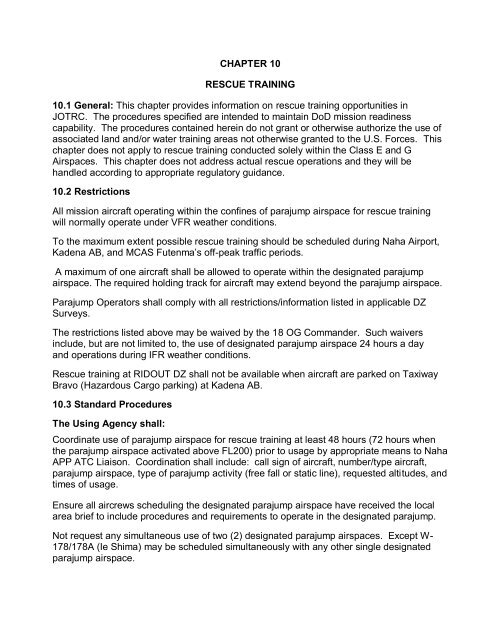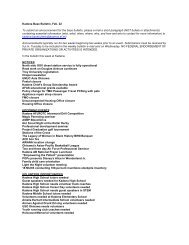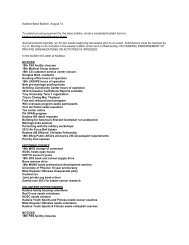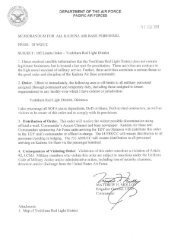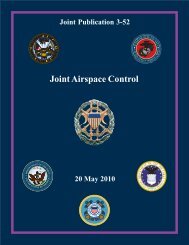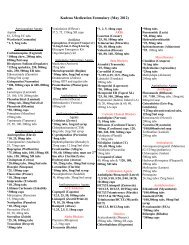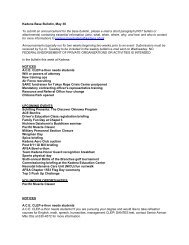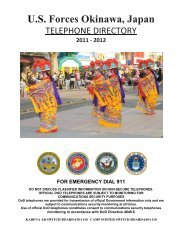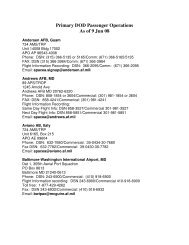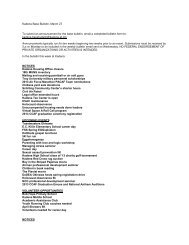JOTRC Handbook - Kadena Air Base
JOTRC Handbook - Kadena Air Base
JOTRC Handbook - Kadena Air Base
You also want an ePaper? Increase the reach of your titles
YUMPU automatically turns print PDFs into web optimized ePapers that Google loves.
CHAPTER 10<br />
RESCUE TRAINING<br />
10.1 General: This chapter provides information on rescue training opportunities in<br />
<strong>JOTRC</strong>. The procedures specified are intended to maintain DoD mission readiness<br />
capability. The procedures contained herein do not grant or otherwise authorize the use of<br />
associated land and/or water training areas not otherwise granted to the U.S. Forces. This<br />
chapter does not apply to rescue training conducted solely within the Class E and G<br />
<strong>Air</strong>spaces. This chapter does not address actual rescue operations and they will be<br />
handled according to appropriate regulatory guidance.<br />
10.2 Restrictions<br />
All mission aircraft operating within the confines of parajump airspace for rescue training<br />
will normally operate under VFR weather conditions.<br />
To the maximum extent possible rescue training should be scheduled during Naha <strong>Air</strong>port,<br />
<strong>Kadena</strong> AB, and MCAS Futenma’s off-peak traffic periods.<br />
A maximum of one aircraft shall be allowed to operate within the designated parajump<br />
airspace. The required holding track for aircraft may extend beyond the parajump airspace.<br />
Parajump Operators shall comply with all restrictions/information listed in applicable DZ<br />
Surveys.<br />
The restrictions listed above may be waived by the 18 OG Commander. Such waivers<br />
include, but are not limited to, the use of designated parajump airspace 24 hours a day<br />
and operations during IFR weather conditions.<br />
Rescue training at RIDOUT DZ shall not be available when aircraft are parked on Taxiway<br />
Bravo (Hazardous Cargo parking) at <strong>Kadena</strong> AB.<br />
10.3 Standard Procedures<br />
The Using Agency shall:<br />
Coordinate use of parajump airspace for rescue training at least 48 hours (72 hours when<br />
the parajump airspace activated above FL200) prior to usage by appropriate means to Naha<br />
APP ATC Liaison. Coordination shall include: call sign of aircraft, number/type aircraft,<br />
parajump airspace, type of parajump activity (free fall or static line), requested altitudes, and<br />
times of usage.<br />
Ensure all aircrews scheduling the designated parajump airspace have received the local<br />
area brief to include procedures and requirements to operate in the designated parajump.<br />
Not request any simultaneous use of two (2) designated parajump airspaces. Except W-<br />
178/178A (Ie Shima) may be scheduled simultaneously with any other single designated<br />
parajump airspace.


